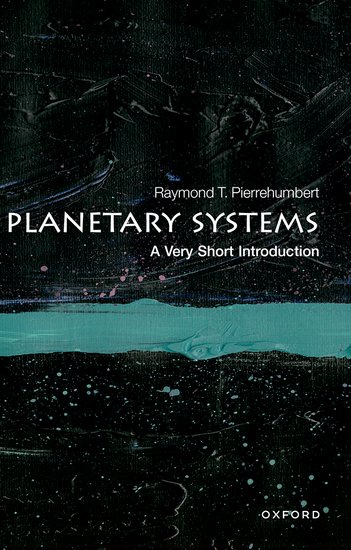Home >
A Very Short Introduction >
Planetary Systems (Science)
A Very Short Introduction | Science
Planetary Systems
ISBN: 9780198841128
Series: A Very Short Introduction
Planetary Systems (Science)
A Very Short Introduction Planetary Systems (Science) Media > Books > Non-Fiction > Education Books Expect Delays of Up to 4 Weeks| Order Below |
ISBN
9780198841128 (10-digit ISBN: 0198841124)
- Description
- Key Features
- Series Description
- Table of Contents
- Introduces the latest developments in understanding the formation and properties of planetary systems
- Shows how scientists are beginning to lift the veil on the question of whether we are alone in the Universe
- Discusses what planets are made of, and where the ingredients come from
- Describes what happens at The End of the Universe
Not long ago, the Solar System was the only example of a planetary system - a star and the bodies orbiting it - that we knew. Now, we know thousands of planetary systems, and have even been able to observe planetary systems at the moment of their birth.
This Very Short Introduction explores this new frontier, incorporating the latest research. The book takes the reader on a journey through the grand sweep of time, from the moment galaxies begin to form after the Big Bang to trillions of years in the future when the Universe will be a dilute soup of dim galaxies populated mostly by red dwarf stars. Throughout, Raymond T. Pierrehumbert introduces the latest insights gained from a new generation of telescopes that catch planetary systems at the moment of formation, and to the theoretical advances that attempt to make sense of these observations. He explains how the elements that make up life and the planets on which life can live are forged in the interiors of dying stars, and make their way into rocky planets. He also explores the vast array of newly discovered planets orbiting stars other than our own, and explains the factors that determine their climates. Finally, he reveals what determines how long planetary systems can live, and what happens in their end-times.
Oxford's Very Short Introductions series offers concise and original introductions to a wide range of subjects--from Islam to Sociology, Politics to Classics, Literary Theory to History, and Archaeology to the Bible.
Not simply a textbook of definitions, each volume in this series provides trenchant and provocative--yet always balanced and complete--discussions of the central issues in a given discipline or field. Every Very Short Introduction gives a readable evolution of the subject in question, demonstrating how the subject has developed and how it has influenced society. Eventually, the series will encompass every major academic discipline, offering all students an accessible and abundant reference library.
Whatever the area of study that one deems important or appealing, whatever the topic that fascinates the general reader, the Very Short Introductions series has a handy and affordable guide that will likely prove indispensable.
Please note: As this series is not ELT material, these titles are not subject to discount.
1:Beginnings
2:Creation revealed
3:Beautiful theories, ugly facts
4:What are planets made of?
5:A grand tour of exoplanets
6:Planetary climate and habitability
7:How it all ends
Further Reading
Index
Not long ago, the Solar System was the only example of a planetary system - a star and the bodies orbiting it - that we knew. Now, we know thousands of planetary systems, and have even been able to observe planetary systems at the moment of their birth.
This Very Short Introduction explores this new frontier, incorporating the latest research. The book takes the reader on a journey through the grand sweep of time, from the moment galaxies begin to form after the Big Bang to trillions of years in the future when the Universe will be a dilute soup of dim galaxies populated mostly by red dwarf stars. Throughout, Raymond T. Pierrehumbert introduces the latest insights gained from a new generation of telescopes that catch planetary systems at the moment of formation, and to the theoretical advances that attempt to make sense of these observations. He explains how the elements that make up life and the planets on which life can live are forged in the interiors of dying stars, and make their way into rocky planets. He also explores the vast array of newly discovered planets orbiting stars other than our own, and explains the factors that determine their climates. Finally, he reveals what determines how long planetary systems can live, and what happens in their end-times.
Key Features
- Introduces the latest developments in understanding the formation and properties of planetary systems
- Shows how scientists are beginning to lift the veil on the question of whether we are alone in the Universe
- Discusses what planets are made of, and where the ingredients come from
- Describes what happens at The End of the Universe
Series Description
Oxford's Very Short Introductions series offers concise and original introductions to a wide range of subjects--from Islam to Sociology, Politics to Classics, Literary Theory to History, and Archaeology to the Bible.
Not simply a textbook of definitions, each volume in this series provides trenchant and provocative--yet always balanced and complete--discussions of the central issues in a given discipline or field. Every Very Short Introduction gives a readable evolution of the subject in question, demonstrating how the subject has developed and how it has influenced society. Eventually, the series will encompass every major academic discipline, offering all students an accessible and abundant reference library.
Whatever the area of study that one deems important or appealing, whatever the topic that fascinates the general reader, the Very Short Introductions series has a handy and affordable guide that will likely prove indispensable.
Please note: As this series is not ELT material, these titles are not subject to discount.
EASY ORDER FORM
PRICES LISTED INCLUDE CONSUMPTION TAX
Price Before Tax:
¥1,790


